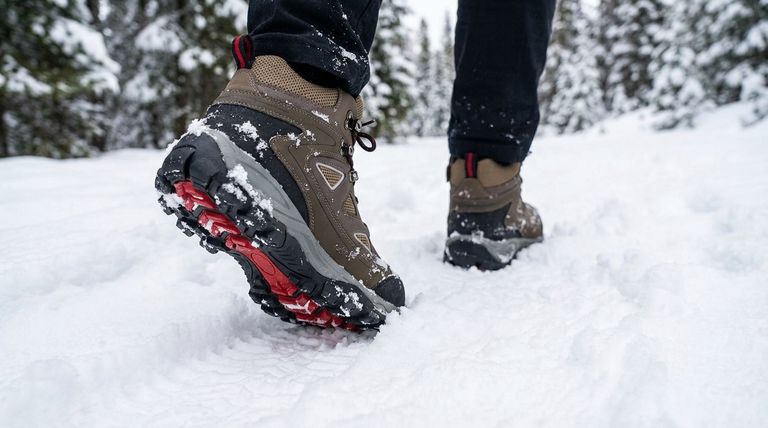To put it directly, user experiences with Hunter boots in snow are mixed and highly conditional. While their rubber construction makes them completely waterproof against slush and melting snow, they provide almost no insulation, leading to cold feet in freezing temperatures without significant modifications.
The core issue is one of purpose. Hunter boots are designed as high-quality rain boots, not snow boots. They excel at keeping you dry but fail to provide the essential warmth and specialized traction required for true winter conditions.

The Core Function: Waterproofing
Hunter boots are fundamentally built to keep water out, a quality that is certainly beneficial in wet, snowy conditions.
Natural Rubber Construction
The boots are made from vulcanized natural rubber, which creates an impermeable barrier against moisture. This is highly effective for walking through slush or wet, heavy snow.
Sealed Seam Design
Unlike stitched boots that can leak over time, the seamless design ensures your feet remain completely dry from external wetness.
The Critical Weakness: Lack of Insulation
The very material that makes Hunter boots waterproof also makes them cold. This is their single biggest failure in a winter environment.
Rubber Conducts Cold
Rubber is not an insulator; it is a conductor. It will quickly transfer the cold from the snow and ground directly to your foot, leading to discomfort and potential risk in freezing weather.
The Necessity of Liners or Thick Socks
To make them bearable in the cold, users universally report the need for thick wool socks or, more effectively, Hunter's own fleece boot liners. This adds bulk and an extra cost to make the boots functional for winter.
The Often-Overlooked Factor: Traction
While waterproofing and warmth are primary concerns, grip is a critical safety factor on winter surfaces.
Standard Sole Design
The standard Hunter boot sole is designed for wet pavement and muddy fields, not for ice or compacted snow. It lacks the deep, multi-directional lugs found on dedicated snow boots.
Performance on Ice
User experience indicates that traction on icy patches is poor. The flat, hard rubber can become slick, increasing the risk of slips and falls compared to boots with softer, specialized winter-grip compounds.
Understanding the Trade-offs
Choosing to wear Hunter boots in the snow is a decision based on compromising performance for style and versatility.
Hunter Boots: Style and Mild Conditions
For a short walk through a light dusting of snow or on a mild winter day with slushy streets, they can suffice, especially with liners. Their iconic style is a major reason people choose to adapt them for winter use.
Dedicated Snow Boots: Warmth and Safety
A purpose-built snow boot offers superior insulation (often temperature-rated), better ankle support, and a high-traction outsole designed specifically for snow and ice. They prioritize function and safety over all-season style.
The Cost of Retrofitting
Consider that purchasing a pair of Hunter boots plus the necessary fleece liners can often bring the total cost close to, or even exceed, the price of a high-quality, dedicated pair of snow boots.
Making the Right Choice for Your Needs
- If your primary focus is style in mild, slushy city conditions: Hunter boots with a fleece liner can be a functional and fashionable choice for short periods.
- If your primary focus is warmth in consistently cold temperatures: You absolutely need a dedicated, insulated snow boot.
- If your primary focus is safety on icy or deep-snow terrain: The superior traction and support of a purpose-built snow boot are non-negotiable.
Ultimately, understanding the boot's intended design as a rain boot is the key to using it effectively and knowing when to choose a safer, warmer alternative.
Summary Table:
| Feature | Performance in Snow | Key Takeaway |
|---|---|---|
| Waterproofing | Excellent (Natural Rubber) | Keeps feet dry in slush and wet snow. |
| Insulation | Poor (Conducts Cold) | Requires thick socks or fleece liners for warmth. |
| Traction | Limited (Standard Sole) | Poor grip on ice; not ideal for slippery conditions. |
| Best For | Style in mild, slushy conditions | A compromise for short-term use, not deep winter. |
Need reliable, all-weather footwear for your customers?
As a large-scale manufacturer, 3515 produces a comprehensive range of durable boots and shoes for distributors, brand owners, and bulk clients. Whether you need insulated winter boots with superior traction or versatile all-season styles, our production capabilities ensure quality and consistency.
Contact our team today to discuss your footwear needs and explore our catalog.
Visual Guide

Related Products
- Safety Footwear Wholesale Manufacturer for Custom OEM/ODM Production
- High Performance Fire-Retardant Waterproof Safety Boots
- Premium Wholesale Waterproof Safety Boots High Performance Protection for Industrial Markets
- Premium Flame-Retardant Waterproof Safety Boots and Shoes
- Premium Grain Leather Safety Boots for Bulk Supply
People Also Ask
- Is it normal to wear shoes in the house? A Guide to Hygiene, Comfort & Culture
- How long can you wear safety boots? The Lifespan is Determined by Wear, Not Time
- Is safety-toe as good as steel toe? Choose the Right Protection for Your Job
- What are OSHA approved shoes? Understanding the Correct Standards for Workplace Safety
- How do safety shoes contribute to cost savings for companies? A Strategic Investment in Risk and Cost Management



















